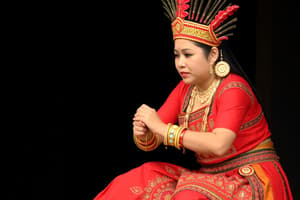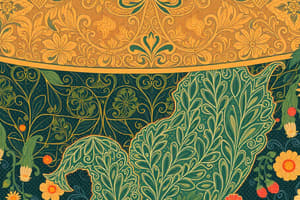Podcast
Questions and Answers
Who revived the Burnay pottery in Ilocos Sur?
Who revived the Burnay pottery in Ilocos Sur?
Teofilo 'Namtiko' Garcia
When was the poem 'Bonsai' by Edith Tiempo published?
When was the poem 'Bonsai' by Edith Tiempo published?
December 23, 1972
What does 'Mangamaru' translate to in English?
What does 'Mangamaru' translate to in English?
Wild Cricket Catchers
Who is the artist of 'Mother and Child' and when was it created?
Who is the artist of 'Mother and Child' and when was it created?
What does the Higantes Festival honor?
What does the Higantes Festival honor?
What is Ambahan?
What is Ambahan?
Who composed 'Sarung Banggi' and when?
Who composed 'Sarung Banggi' and when?
When was 'The Builders' sculpture unveiled?
When was 'The Builders' sculpture unveiled?
What materials were used to build St. John Nepomuceno Baroque Church?
What materials were used to build St. John Nepomuceno Baroque Church?
What does the Lapu-Lapu Monument commemorate?
What does the Lapu-Lapu Monument commemorate?
What does 'Tennun' mean in Yakan?
What does 'Tennun' mean in Yakan?
What is the purpose of the Kahimunan Festival?
What is the purpose of the Kahimunan Festival?
What is the symbolic meaning of the Sarimanok?
What is the symbolic meaning of the Sarimanok?
Flashcards
Burnay Pottery
Burnay Pottery
Pottery revived by Teofilo "Namtiko" Garcia, influenced by Chinese techniques, featuring rustic designs and used for storage.
"Bonsai" Poem
"Bonsai" Poem
Poem by Edith Tiempo written in 1972 that explores love and memories through the metaphor of a bonsai.
Mangamaru Folk Dance
Mangamaru Folk Dance
Kapampangan folk dance mimicking mole cricket hunting, reflecting survival and resilience.
"Mother and Child"
"Mother and Child"
Signup and view all the flashcards
Higantes Festival
Higantes Festival
Signup and view all the flashcards
Ambahan
Ambahan
Signup and view all the flashcards
Sarung Banggi
Sarung Banggi
Signup and view all the flashcards
The Builders
The Builders
Signup and view all the flashcards
St. John Nepomuceno Baroque Church
St. John Nepomuceno Baroque Church
Signup and view all the flashcards
Lapu-Lapu Monument
Lapu-Lapu Monument
Signup and view all the flashcards
Kuratsa Dance
Kuratsa Dance
Signup and view all the flashcards
Tennun
Tennun
Signup and view all the flashcards
Sarimanok
Sarimanok
Signup and view all the flashcards
Study Notes
Ilocos Sur: Burnay Pottery
- Collective of artisans, notably revived by Teofilo "Namtiko" Garcia.
- Originated in the 16th century, heavily influenced by Chinese pottery techniques.
- Characteristics include rustic designs, earthenware material, primarily used for storage.
Nueva Vizcaya: "Bonsai" Poem by Edith Tiempo
- Written on December 23, 1972, by poet Edith Tiempo.
- Explores themes of love and memories, symbolizing their small yet significant role in life through the bonsai metaphor.
Pampanga: Mangamaru Folk Dance
- Created by the Kapampangan people with no exact date of origin.
- The dance mimics the hunting of mole crickets, reflecting themes of survival and resilience.
- The term “Mangamaru” translates to "wild cricket catchers" (Maru = Cricket).
NCR - Malabon: "Mother and Child" by Benedicto Cabrera
- Artwork by Benedicto Cabrera, completed in 1942.
- Centers on maternal love and the challenges of motherhood, embodying the artist's personal empathy as a firstborn.
Region IV-A (CALABARZON): Higantes Festival
- Notable artists include Carlos 'Botong' Francisco, Artemio Tajan, and Maestro Lucio San Pedro.
- Originated in the late 1800s during the Spanish colonial period and was formalized in the 1980s.
- Honors Saint Clement and features giant papier-mâché figures, serving as a symbol of agrarian protest.
Region IV-B (MIMAROPA): Ambahan
- Traditional poetry of the Hanunoo Mangyans, rooted in centuries-old cultural heritage.
- Represents the rich storytelling and lyrical tradition of the Mangyan people.
Region V (Bicol): Sarung Banggi
- Composed by Potenciano Gregorio on May 10, 1910.
- A famous Bicolano love song, known as "One Night," narrating an enchanted evening encounter.
Cordillera Administrative Region (CAR): The Builders
- Sculpture by Ben Hur G. Villanueva, created with assistance from his sons and unveiled in September 2009.
- Honors the contributions of individuals who participated in the construction and development of Baguio City.
Region VI: St. John Nepomuceno Baroque Church
- Located in Anini-y, Antique; built between 1630-1638 by Augustinian Friars, and rebuilt from 1845-1879.
- Made from coral reefs, using egg whites and yolks as binding materials.
- Served multifaceted roles in society: religious, cultural, social, and political during the Spanish Colonial Period.
- Dedicated to St. John of Nepomuceno, recognized as a protector against floods and drowning.
Region VII: Lapu-Lapu Monument
- Located at Mactan Shrine in Cebu, unveiled in 1981 following Republic Act 5695.
- Created to honor Datu Lapu-Lapu, who resisted colonization during the Battle of Mactan on April 27, 1521.
- Symbolizes Filipino courage and the struggle for independence.
Region VIII: Kuratsa Dance
- Originated from the Mexican dance "La Cucaracha" but lacks a specific creation date.
- Reflects the influence of Spanish colonization (1565-1868) and is popular in Leyte and Samar during fiestas, reunions, and weddings.
- Thematically represents flirtation and courtship, akin to roosters' mating rituals.
Region IX: Tennun
- A weaving tradition among the Yakan people in Lamitan, Basilan.
- "Tennun" translates to "woven cloth" in Yakan, showcasing designs inspired by nature, daily life, and Islamic symbols.
Region X: Vega Ancestral House
- Located in Balingasag, Misamis Oriental, built by Ignacio Juan Vega in the late 1800s.
- Owned by Maria Clara Vega Jimenez, constructed from molave wood featuring intricate carvings.
Region XI: Giant Durian Genesis Lore
- Situated at Davao International Airport, Sasa, Davao City.
- Created by artist Rey Mudjahid Ponce Millan (Kublai Millan), the sculpture illustrates a halved durian fruit containing six figures.
- Represents the three major groups of Mindanao: Lumad, Bangsamoro, and Christian settlers.
Region XII: T’nalak
- Originates from Lake Sebu in Mindanao, crafted from abaca fibers.
- Uses a backstrap loom and ikat dyeing techniques and is significant in rituals, festivals, and barter economies.
Region XIII: Kahimunan Festival
- Held in Butuan City, Agusan del Norte on January 3.
- Serves as a Thanksgiving celebration to Santo Niño, showcasing indigenous practices.
Bangsamoro: Sarimanok
- Located in the Bangsamoro Autonomous Region in Muslim Mindanao (BARMM).
- A bird-like creature often depicted with a fish, symbolizing flight and wealth, associated with Maranao royalty and used in official emblematic representations.
Studying That Suits You
Use AI to generate personalized quizzes and flashcards to suit your learning preferences.




